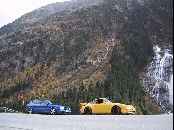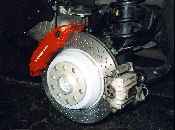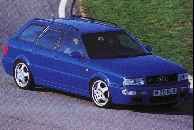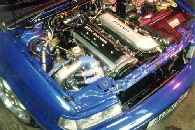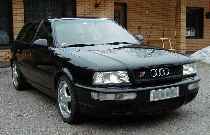Porsche's Station Wagon
By: Road & Track
As a general rule,
I don't like Audis, I don't like four wheel drive, I'm not too fond
of Turbocharged engines and I reckon estate cars are but a step away
from caravan ownership. So how come my nomination is the RS2, Audi's
four wheel drive Turbocharged super estate? Well lets get a few things
straight.
This is Porsche's interpretation of an Audi, which
means some life has been massaged into the normally numb steering,
the bumpy gearshift is tighter and more positive and the chassis has
been to one of the worlds best finishing schools. A few choice tweaks
and a little brain surgery have coaxed a whopping 315 hp from the
charismatic in-line 'five' and its explosive delivery would give front
or rear drive no chance, hence all wheel drive is valid. The estate
car body?
Call it a visual gag, the element of surprise or simply useful,
nobody is going to think caravans as it overtakes and disappears.
The RS2 is devastating all-weather point to point car, not so much
a Porsche in disguise as an Audi with an attitude. That makes it the
first since the Quattro which won our inaugeral Performance Car of
the year contest five years ago. The RS2 is more powerful, faster,
handles better and has great brakes (borrowed from the Porsche 968
Club Sport). Its feedback won't leave you buzzing - there's only so
much Porsche could do with original ingredients - but it covers ground
at such an astonishing rate, with such confidence and composure that
it seems hardly to matter.
The RS2 is no ordinary car. Its power, brakes and handling combine
to make it a finely tuned weapon, a blade for carving through traffic
which would obstruct less dynamic vehicles.
Its life has been
short as right-hand drive production was limited to just 180 at a
substantial price premium over the S2 Estate. The S2 is no mean performer,
but alongside the RS2 its acceleration seems slow, its handling less
sharp and its brakes relatively inadequate.
How does the RS2
achieve this superiority? There's no magic about it, despite the
Porsche name on the badges and the inlet manifold. Changes have been
made to engine, suspension and brakes, but most of them are relatively
straightforward and have already been practised by some German tuning
houses.
Let's look at the engine first. Extracting more power from a turbo
charged engine is not a mystery, but ensuring that big outputs can
be delivered reliably over high mileages requires careful development.
The 20-valve five-cylinder unit is much stronger than the 10-valve
and, as has been recognised for some time, its mechanical components
can cope with large volumes of torque and power.
Development
work, in conjunction with Porsche, has resulted in a package which
is little different to those offered by Nothelle or Schmidt, with one
or two exceptions. All the standard tricks are there, bigger turbocharger
and modified engine management, but the RS2 has a larger-diameter
exhaust manifold, bigger intercooler and different camshafts, a feature
which undoubtedly accounts for the lack of pull below 3000rpm and the
subsequent, shocking surge which rushes the car forward very strong
at about 4500rpm and continuing to the limit of about 7000 so quickly
that it is sometimes difficult to avoid catching the rev limiter.
The RS2's power delivery will inevitably be compared with that of the
S2, whose engine is relatively free from turbo-lag and with maximum
torque developing below 2000rpm. Even when the engine is burbling
away close to tickover, there is little delay before the power comes
in when you floor the throttle. It is not perfect, but response is
smooth without any great step in power delivery.
The RS2 is
a very different kettle of fish, echoing early Ur-quattros in the
way its engine responds to the throttle. There is little torque below
3000rpm, but then the surge is enormous. As with modified S2s, it is
necessary to be in a gear which keeps the engine close to this mark,
if you want to take advantage of overtaking opportunities. It is no
good seeing a gap, changing down and then accelerating; the chance
will have passed because the gear change, while better than most S2s
we have driven, is still ponderous. Because of this, you are often
at higher revs than you would like, making driving less restful.
The suddenness with which power comes in is far greater than similarly
powered modified S2s we have driven and this must largely be due to
the camshafts. It is hugely exhilarating, but in lime becomes wearing.
As you will see from the comparison chart, performance is similar to
that of a Nothelle N300 S2, a car which exhibits noticeably less lag.
The N300 engine feels almost soft in comparison, its response much
smoother, despite delivering similar levels of power and torque.
Fuel consumption turned out to be much as expected on British roads.
Use the lower gears to a greater extent or wind it up to cruise at
150mph or more on autobahns and you'll find that it drops to about
18mpg. The computer was strongly pessimistic, suggesting that fuel
was being guzzled at a disappointing rate. This is unusual: VAG
computers usually flatter fuel consumption.
Relatively little has been done to the suspension, but the small
changes have a substantial effect. The RS2 uses the same coil springs
as the S2 Estate, so the car is no lower. The S2 has Boge shock
absorbers, which are very good, but the RS2 has Bilsteins, which
offer firmer damping. Both anti-roll bars have a greater diameter,
28mm at the front (instead of 26mm) and 16mm at the rear (12.5mm).
The combination of firmer damping and heavier anti-roll bars combine
to reduce the amount of roll on corners, making the RS2 much more
enjoyable to drive on winding roads. This does not cost too much in
terms of ride quality, with comfort remaining quite acceptable,
although some might find it rather hard.
Some of the credit for this must go to the SP8000 tyres, the only
type which Audi recommends for the RS2. Their section is 245/40,
leading one to assume that ride would be very hard, but they are on
7in. rims, narrower than you would expect, causing the tyres to bulge
somewhat, rather than sitting flat on the wheel. The standard S2 wheel
has a width of 7.Sin. for a 205-section tyre and this makes the RS2
combination look odd. Despite this, it works well and there is no
suggestion of the elasticity which sometimes characteristics the
steering of cars which have a wide tyre on a relatively narrow rim.
The changes to the suspension certain-ly reduce the amount of roll,
but the basic handling characteristics remain the same as all the
quattro Audis. When cornering quickly, you can apply power much
earlier than you would expect as the four-wheel drive system maintains
traction even when the surface is slippery. You have to take care:
there is so much torque that it is easy to demonstrate the basic
understeering characteristics, with the front beginning to run wide
unless you ease off the throttle. On bumpy roads, the firm damping
of the Bilsteins ensures that the wheels are not deflected from their
course and steering remains positive as you hurry through bends.
The wheels are what Porsche calls Carrera Cup, a style used on recent
911s. Made in Italy, these attractive alloys have one drawback: the
centre bulges out-wards and is vulnerable to high kerbs. Diameter is
l7in, necessary in order to clear the brake calipers, which are labelled
Porsche and made by Brembo in Italy.
They are a great improvement over those on the S2, but mean that the
wheels and hubs are not compatible with other Audis. Front and rear
discs are ventilated with diameters of 304 and 299mm respectively.
This compares with the 276mm ventilated front and 245mm solid rears
of the S2. Just as important as size is the use of four-piston calipers,
each disc being by two pistons on each side rather than the single-sided
arrangement on the S2.
We expected great things from the brakes
and, from speed, this was fully justified, the car being pulled down
firmly and evenly time after time. But at low speeds the brakes felt
rather dead and required quite high pedal pressures. They don't, for
example, inspire as much confidence at low speeds as those of the A4,
which react more sharply to the pedal. It is when you start to exploit
the RS2's performance that you begin to appreciate what is on offer.
The S2 has the ability to accelerate very quickly past other traffic,
but slotting yourself back into a line shows up the braking limitation.
No such affect the RS2, the brakes cut speed with great strength,
but no drama.
In common with other Porsche disc brakes, the handbrake consists of
a small expanding shoe mechanism inside the drum of the disc, a system
used by BMW and some other manufacturers, but not by Audi until now.
We've always found it an effective form of handbrake, but, untypically,
it did not work well on the test car. Even a hefty heave to pull the
lever up as far as it would go was not sufficient to stop the car
rolling on quite a modest slope and it always had to be left in gear.
One of the reasons why the driver of an RS2 feels in command is that
the front seats are made by Recaro. The usual bolsters are extended
to the top, providing lateral support for the shoulders. Driver and
passenger are held firmly, even when the car's cornering ability is
being exploited to the full. The lack of roll allows you to indulge
in higher cornering speeds than with an S2 and the support is necessary
in order to cope with the higher G-forces.
Controls for the electric motors are neatly tucked away on the front
of the bolster and a manual release under the front of the cushion
allows you to pull the front section forward, giving more thigh support
for those with long legs. Lumbar support is good, but, unlike some
other Recaros, it is not possible to alter it.
Firmly seated, the driver is confronted with the standard Audi air bag
steering wheel, looking rather out of place in such a sporting car.
The air bag is welcome, but the Personal wheel used on pre-air bag
S2s and the Ur-quattro 20V looks more appropriate. Because the RS2
is essentially 80, the steering column is not adjust-able for either
height or reach and many drivers will find it set too high.
The RS2 uses the same six-ratio gear-box as the S2 and TDJ versions
of the 100 and A6. It is not a quick change and, although more precise
than any we had experienced, there is nothing like the slickness which
you get with, for example, a Corrado or an A4. It is quite firmly
spring-loaded to the central plane of third and fourth and pulling
it across to select fifth or sixth requires a definite effort.
This means that a change from fifth to fourth, or third, is slick,
but not in the other direction. The gear knob and gaiter are all in
one, rather like the top versions of the Golf and Corrado. The handbrake
lever, as we have already mentioned, has to be pulled up high, not
too easy if the seat is well forward. This also applies to moving
the gear lever: those who sit close to the wheel may find their elbow
knocking against the seat bolster when they make rapid changes into
third or fifth.
Like the S2, S4 and 56, the RS2 has white instruments with calibrations
that glow red at night. The rev counter is red-lined at 7l00 rpm and
the speedometer, which has mechanical counters for total and trip
mileage, goes to 190mph, giving a margin of about 25mph if you exploit
the car's top speed on an autobahn. There are the usual three instruments
in their unhelpful position at the base of the console. Unlike the other
S cars, the oil temperature gauge and voltmeter are swapped, so that
the temperature gauge is nearer to the driver. This would make sense
if the two right-hand instruments were not obscured by the driver's
arm, the result being that the voltmeter, which is the least useful,
is the only one clearly visible when you glance down.
Above the instruments are the conventional 80-series healing and
ventilation controls, supplemented by the standard air conditioning
switches. The air conditioning is a relatively simple system, which
cannot compare with the climate control on the A4, A6 and AS. The RS2
shares an anachronism with the S2 Estate each passenger has a map-reading
light but not the driver.
It must not be forgotten that the RS2 is an estate car, although it
is likely that the Coupe would have been chosen as a basis if Porsche
was not building competitive vehicles. It is not a big load-carrier
because of its compact dimensions and height of the deck, but with
the divided rear seat folded quite a bit can be packed in. Most of
the time it will be used with the rear seats up, any luggage hidden
by the roller blind cover. The floor is carpeted and, with the RS2's
cornering ability, you can guess what happens to anything you carry
There are securing eyes at each corner and Audi should be supplying
a net to hold everything in place. They are sold widely as accessories
in Germany.
The extra width of the full-size spare creates a problem, as the
standard cover cannot fit over it without causing a bump in the load
deck. This has been overcome by replacing it with a thin aluminium
sheet cover, but one would have to be careful about putting a heavy
load over the middle of it.
Visually, much has been done to make the RS2 look different from the
S2. The front end looks quite different, but all the panels, apart
from the combined bumper and spoiler, are the same. The standard
grilled is replaced by one of black expanded metal within a black
frame and similar material is used to fill the ducts for intercooler
and brakes below the bumper. It is the gaping maw beneath the bumper,
which gives the RS2 its aggressive appearance. Porsche lamps, with
rounded ends, are used in the bumper, which has single headlamp washer
jets. The headlamps are the same as the S2.
At the back, a red reflective panel fills the gap between the rear
lamps and the number plate is displaced to the moulding beneath the
bumper. It makes the RS2 look different to other 80 Estates, but the
aesthetics are questionable. Shapely Porsche mirrors replace the
rectangular Audi versions. The good-looking wheels are set off by
the big Porsche calipers, enamelled in red and clearly visible through
the gaps between the spokes. The front ones soon get a coating of
black brake dust once you start motoring!
Audi and Porsche between them have endowed a very practical car with
sufficient mystique to make it immensely desirable, whatever its
equipment. Little surprise that they were snapped up so quickly.
|

